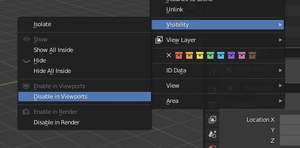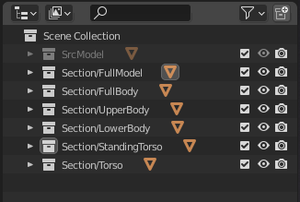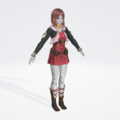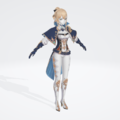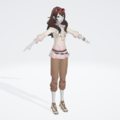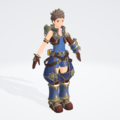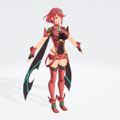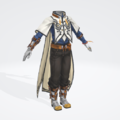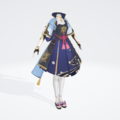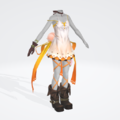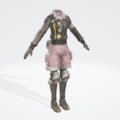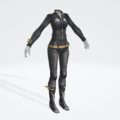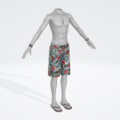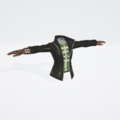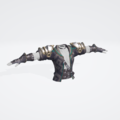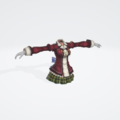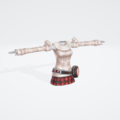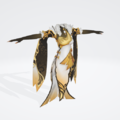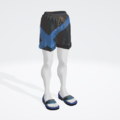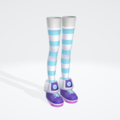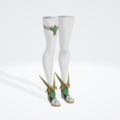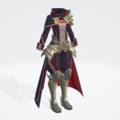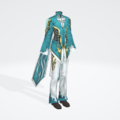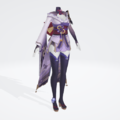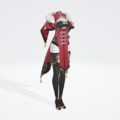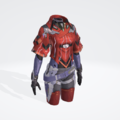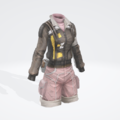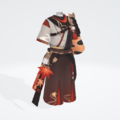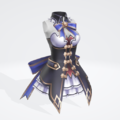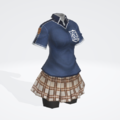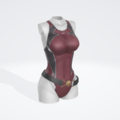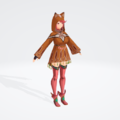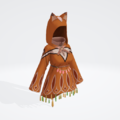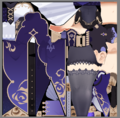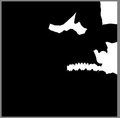Help:Model Processing Guidelines
Guidelines for preparing models for Games Fashion Archive's 3D viewer.
Requirements
- Blender 2.8 or newer
- Model asset files (FBX format preferred)
- A photo editor capable of making color adjustments (Photoshop preferred)
Model files should be fully textured and rigged. Original geometry normals are preferred, but generated normals are also acceptable.
Workflow
The goal of this process is to split models into separate display groups that provide a quality representation of the articles of clothing on the model. Examples of display groups are the Torso and FullBody options in the 3D archive as well as the options for individual clothing items such as Shirt and Pants.
In Blender, each display group is represented by a single Blender Collection. The name of the Collection will become the name of the option shown in the Parts dropdown on the archive. The contents of the collection will be the model shown when the user selects the option.
Collections that have been disabled via the Disable in Viewports option will not be exported. It is recommended that you keep the rigged source model in its own collection and make copies of it as necessary - then disable this collection before exporting.
Model geometry should be preserved in its original state as much as possible. However, minor edits are acceptable if it improves the quality of the presentation. See the Common Edits section for examples of acceptable minor edits.
Primary Display Groups
Archive models have 6 primary display groups. These groups provide an overview of the outfit and are sometimes necessary for showing clothing items with partial or incomplete geometry. Some of these groups may be omitted if the model does not provide effective points for cutting along the section boundaries.
Unlike the collections for individual clothing items, the primary display groups have very specific naming constraints. Blender collections should use the names as shown above.
Full Model
The full model in rest-pose. Arms at ~45° angle from the body.
Full Body
The full body of the model from the neck down. Arms may assume a more relaxed ~35° angle.
Upper Body
The upper half of the model from the waist upwards and from the neck down. Arms should be extended outwards at 90° angles. If the model is a skirted outfit, then the skirt may be included. Draped sleeves should be adjusted using their rigging to properly hang down from the horizontal arm position.
Lower Body
The lower half of the body from the waist downwards. If the model is a skirted outfit, then the model can be cut from the thighs downwards. If shorts are worn under the skirt, they can be included.
Standing Torso
The body of the model from the neck down minus the arms. If the outfit has sleeves, then they should be included as well. If the outfit has asymmetrical sleeves or has an off-sleeve, then both arms should be included in their entirety. If present, arms should be at a low angle down at the sides of the torso.
For arms that are completely bare, the arms should be cut at the shoulders. For shoulder coverings such as cowls or capelets, arms may either be cut at the shoulder, or a bit further down where the clothing item ends - whichever looks better.
Torso
The same as the Standing Torso section, but cut from (approximately) the thighs upwards. If the outfit includes a set of legged-shorts, the cut can be from where the shorts end. If the outfit is a skirted outfit (without shorts), then the legs and hips under the skirt may be omitted. If the outfit has a short cape or tailcoat, then the cut should be roughly equal to the length of that item.
Item Display Groups
Display groups for individual articles of clothing.
Long-Sleeve Shirts
Copied as-is from the Torso section. Arms should be down by the torso.
Short-Sleeve Shirts
Copied as-is from the Full Body section. Sleeves at 45° from the torso.
Pants
Copied from the Lower Body section. Geometry may need to be adjusted if pant legs bunch up around the footwear.
Legged-Shorts
Copied as-is from the Lower Body section.
Gloves
Copied from the Upper Body section. Rotated such that the palms are directly downward if they aren't already. One separate display group for each glove. May include forearm geometry if the gloves are sufficiently small.
Shoes and Boots
Copied from the Lower Body section. If their rest-pose position is such that they are intersecting, then they should be moved apart by an equal distance such that they are no longer intersecting.
Sandals
Copied from the Lower Body section. May include foot geometry cut from the ankles down if sandals include elements not directly connected to the footwear.
Skirts
Copied as-is from the Torso section.
Swimsuit Tops
Copied from the Torso section inclusive of the torso cut from the waist upwards.
Swimsuit Bottoms
Copied from the Torso section inclusive of the torso cut from the waist down.
One-Piece Swimsuits
Copied from the Torso section inclusive of body geometry. Effectively identical to the Torso section minus any accessories.
Earrings
Copied from the Full Model section. If the earrings are a pair, they should be moved close together with their height offset from each other.
It is not necessary to make an earring display group if the earring geometry is overtly simple.
Accessories
Copied from the Full Model section. Rotated to be upright and facing forward.
Common Edits
Common edits that should be done to model sections if needed.
Incomplete Geometry
Clothing articles may have incomplete geometry due to optimization or if part of the item is occluded by outer layers of clothing.
These items may be patched if the missing geometry is sufficiently small. However, this should only be done if the texture also has matching data for the missing geometry. Alternatively, if the texture pattern is sufficiently simple, existing portions of the texture may be re-used for the patched geometry.
If a significant portion of the costume part is missing, discard the display group entirely. The costume part will still be observable using the primary display groups.
Intersecting Geometry
The model rest pose may include intersecting geometry for cloaks, hair, or other accessories. In these cases, model bones should be adjusted to minimize intersections. Adjustments may also be made to the geometry itself as long as it respects the materials of the clothing items being adjusted.
Capped Ends
Openings for sleeves of shirts or pant legs will often be capped to ensure no gaps are shown in the model. These capped ends look unnatural for isolated clothing items and should be removed.
Uneven Ends
Due to occluded and incomplete geometry, the ends of some clothing articles may have jagged or uneven geometry edges. Uneven edges should be flattened out in accordance with the article of clothing being edited.
Mirroring
Clothing articles that would otherwise be symmetrical may have asymmetries due to occluding or incomplete geometry. In these cases, it is acceptable to recreate the occluded sections by mirroring them over from the opposite side of the article.
Hat Interiors
Hats will often have simplified geometry at the point where they cover the head of the character model. This flat geometry may be pulled up into the hat to give it an interior.
Hooded Items
Hoods worn over the head should be cropped from the model for display groups that do not include the head. Raised hoods should only be shown for the Full Model model display group which includes the head and for the display group that only includes the hooded clothing item in isolation. Lowered hoods that are not worn on the head can be included in all applicable display groups without any special considerations.
Textures
Skin tones and facial features should be de-emphasized using a masked Hue/Saturation Adjustment Layer with saturation reduced to 0. These edited textures should be used for all display groups with the exception of the Full Model display group which may use the original full color textures.
Exporting
TBD
